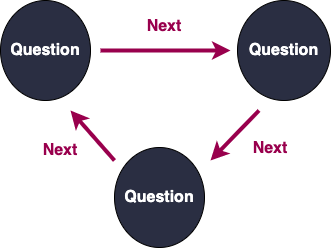This is an exploratory attempt to model Questionnaire that is similar to Google Form, SurveyMonkey and Typeform. The focus will be on conceptual modelling instead of implementation.
Scope
- Questionnaire will consist of multiple choice only for simplicity. We can easily extend the model to cater free text, numeric field or other types of input.
- Question can have ordering.
- Dynamicity: Whether a question should be asked depends on previous answer, i.e. follow-up question
- Versioning: Being able to keep track of changes, and revert back to specific version of the questionnaire.
Linear Question
Let’s start with something simple - a Linear Questionnaire without versioning.
We are going to create questionnaire about Pet. There will be two questions in order: Do you like animals?, Do you have any pets?.

As shown in the graph, there are three entities: Questionnaire, Question and Answer. The arrows represent relationships between entities.
next works as pointers here:
- To get the first question of the questionnaire, we search for the question that is not being pointed.
- To find the next question, refer to what
nextpoints to. - The questionnaire ends when there is no
nextrelation found.
With Question and Next, we have created a directed graph. Next, we have to validate if it is a Directed Acyclic Graph (DAG). A DAG means is a graph that is directed and without cycles connecting the other edges. If it is not a DAG, we may result in an infinite loop of questions.
For example:

Once it is validated, we can find out the order of the questions by Topological Sort. The explanation of the algorithm can be found here.
Questions have been set. We are ready to capture responses.
Response
A user named John responses the two questions with Yes.

Timestamp is for recording when user responses to a question. Noted that a user can response to a question multiple times. We get the most updated answer by searching for the latest Timestamp.
Dynamic Question
If user answers Yes to Do you have any pets?, we would ask him/her a follow-up question, How many pets do you have?.

We introduce the new relationship FollowUpBy between Answer and Question. If user responses with a specific answer, we will see if that leads to a follow-up question.
Noted that we may need to update the way to find the first, next and last question accordingly. We also have to extend the sorting algorithm to cater for the new relationship type. Nonetheless, It should be straight forward.
Dynamic Questions have been set. Next part would be Versioning.